Fragrant Snowbell: Styrax obassia
Street tree selection is a tricky undertaking. Good candidates should be able to thrive in less than ideal conditions, (think limited growing space, ice melt, and Fido making his daily pit stop to name just a few obstacles), be of a habit that is generally upright, (no one wants a branch in the face), yet not grow large enough to tangle with utility wires or upheave walkways and paving. A candidate should ideally possess multi-season interest: flowers, showy fall color, interesting bark patterns. One such tree, seen throughout Swarthmore and found growing at the Scott Arboretum, is Styrax obassia, the fragrant snowbell.
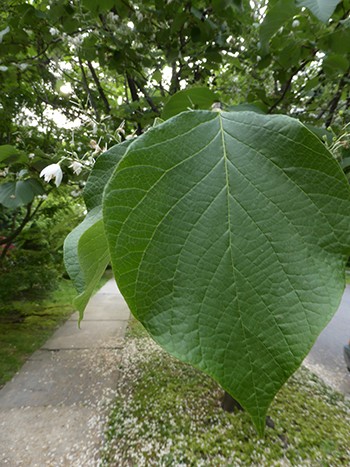
Substantial ovate leaves, dark green in color with a dense pubescence on the underside, cover the tree. photo credit: J. Coceano
Styrax obassia is indigenous to Japan, Korea, and Manchuria. The small-statured deciduous tree generally grows 20 to 30 feet in height. Substantial ovate leaves, dark green in color with a dense pubescence on the underside, cover the tree.
Racemes of fragrant white flowers bloom in mid-May. Despite flowering after the leaves have fully emerged, the sheer volume of flowers makes for a stunning display. Each flower raceme is composed of several dozen individual pendant fragrant white flowers. Another, albeit fleeting, display occurs when individual flowers fall and blanket the ground.
Fertilized flowers give way to small ¾” drupes. Leaves transition to golden yellow in the autumn. Bark is smooth and becomes slightly furrowed along the trunk with age.
Fragrant snowbell is best suited to full sun and partial shade locations. Trees grow, but flowering is reduced if planted in dense shade. Transplanting is most successful with small trees planted in spring. While S. obassia has shown great promise as a street tree throughout Swarthmore, care should be given to appropriately prepare the planting site. A well-dug, well-aerated and amended soil will help ensure success.
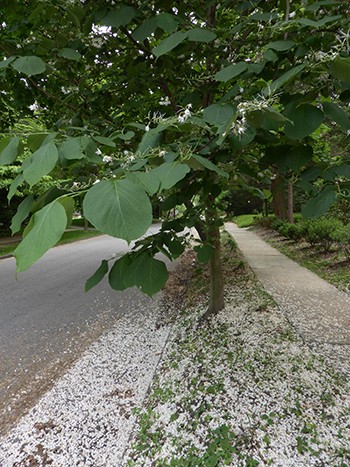
An ideal street tree, seen throughout Swarthmore and found growing at the Scott Arboretum, is Styrax obassia, the fragrant snowbell. photo credit: J. Coceano
While suitable for street tree situations, Styrax obassia would be an ideal candidate for any small scale space or as an understory tree. Three accessions are currently growing at the Scott Arboretum. Numerous trees can also be seen along Cedar Lane and Ogden Avenue.





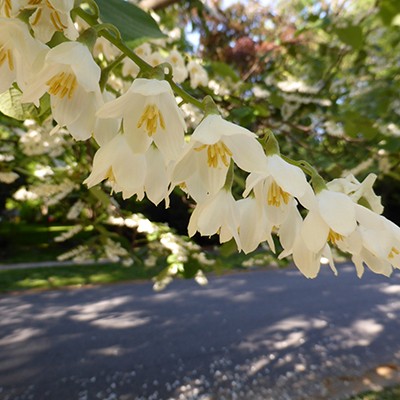
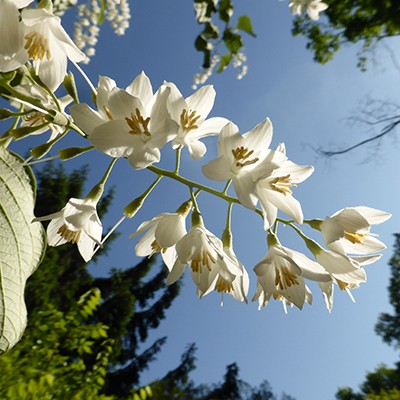
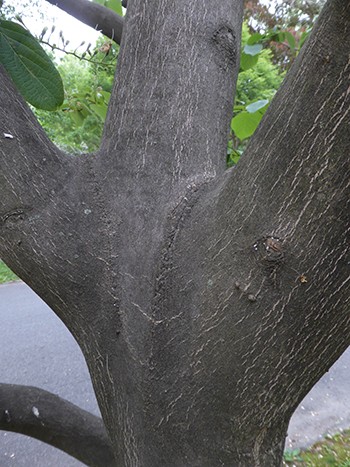
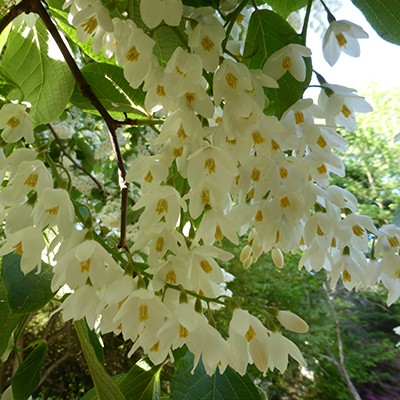
Diane Mattis
Posted at 10:01h, 26 MayOh how beautiful! Now I want one for my front lawn
when I take down the Crabapple. Thank you for all of
this information!
Josh Coceano
Posted at 15:02h, 27 MayThank you, Diane
Styrax obassia is quite spectacular in bloom and would be a great replacement for your crabapple.
John Schucker
Posted at 21:23h, 27 MayI was very happy to procure a small specimen of Styrax obassia recently, having wanted to try one for years. Mine is barely 6 feet tall and certainly will not flower this season, but the large round leaves and early evidence of a graceful branching habit already make it a lovely and unique presence. Choosing something as substantial as a tree for the landscape is always a process over which I deliberate for quite some time. Your glowing comments, Josh, reinforce my enthusiasm for having made this choice. Thank you.
Vicki Stone
Posted at 15:42h, 28 MayI have this tree in my garden, having grown it from seed about 10 years ago, and always look forward to its bloom. It seeds in quite a bit, and I have several saplings growing under the mother tree. Also has a tendency to be multi-trunked, but can be trained to a single trunk. Contact me if you would like a sapling. Nearly impossible to find in the trade.
marie carbo
Posted at 21:53h, 11 Junewonderful to see a tree flowering like this….
A delight as a street tree!
Pascale
Posted at 15:32h, 02 DecemberHello- I planted a styrax obassia about 4 years ago. It is growing very well and is about 10 feet tall now, however, it has never bloomed. It gets good sun with protection just beyond a wooded edge and I keep it mulched and sprayed to repel deer. It’s growing in rich organic soil. Does anyone know at what age it should bloom? I’ve been patiently waiting…..Thanks!
Mary Tipping
Posted at 12:52h, 16 DecemberSorry to hear that you are still waiting for your Styrax obassia to bloom. I don’t know of any specific reason for this species not to bloom. If possible, you may want to relocate the tree to a full-sun location.
david evans
Posted at 20:15h, 05 JuneI also have a young Styrax obassia that has not flowered. It grows in full sun, wuite close to a Styrax japonica that has bloomed since it was a whip. Any thoughts as to how to encourage blooms or if there is something required in the surroundings that miht help?
Becky Robert
Posted at 12:27h, 21 JuneHi David,
Styrax obassia are beautiful trees! I’m uncertain as to why yours hasn’t bloomed. How old would you say the young tree is? Sometimes a tree needs to reach a certain internal age before it’ll bloom. Davidia are notorious for this.
Lisa Dustin
Posted at 11:11h, 10 JulyI planted a styrax obassia in my West Philadelphia backyard about 15 years ago. It has been a great tree, blooming reliably every year. However, last year one half of the tree showed signs of severe stress (droopy leaves). This year, although the less stressed side it bloomed in May as always, it now shows severe signs of stress and it’s pretty clear that it’s dying. I cannot think of any environmental changes in my yard, except the increasing size and density of a river birch to the east of this tree. Any thoughts would be greatly appreciated. I’d like to replace it in kind, but am reluctant to do so without knowing the cause of the sudden demise of this one. Thank you!
Becky Robert
Posted at 13:06h, 10 JulyJoshua Coceano
2:03 PM (1 minute ago)
to me
My personal observation has been that Styrax obassia are durable trees – there are quite a few planted in Swarthmore as street trees and I’ve been very impressed with their performance.
Actions / thoughts:
* Has the tree maxed out the growing space allotted thus leading to decline?
* University of Connecticut does list it as a “a delicate plant that can thrive for several years and die abruptly.” http://hort.uconn.edu/detail.php?pid=479
* Vascular ailment-either fungal or bacterial. Discuss further with a tree care specialist.
Sincerely,
Josh Coceano
Horticulturist
Scott Arboretum
Joel Nuss
Posted at 10:45h, 04 AugustI am the proud owner of Styrax Obassia here on Long Island, New York. I planted it at 6′ tall and that was 20 years ago.
It has successfully flowered every year but I have noticed that the leaves, originally the size of my hand, are now rather small.
The flowering has also declined.
It has plenty of room around it and a low garden under it.
It reached its max growth of about 25′ tall and and about 20 wide, many years ago.
Full sun.
Is it age that prevents the leaves from growing large or should I prune it?
you can view a pic of my Stryrax here: http://www.shaqari.com/gardening
Thanks!
Joel